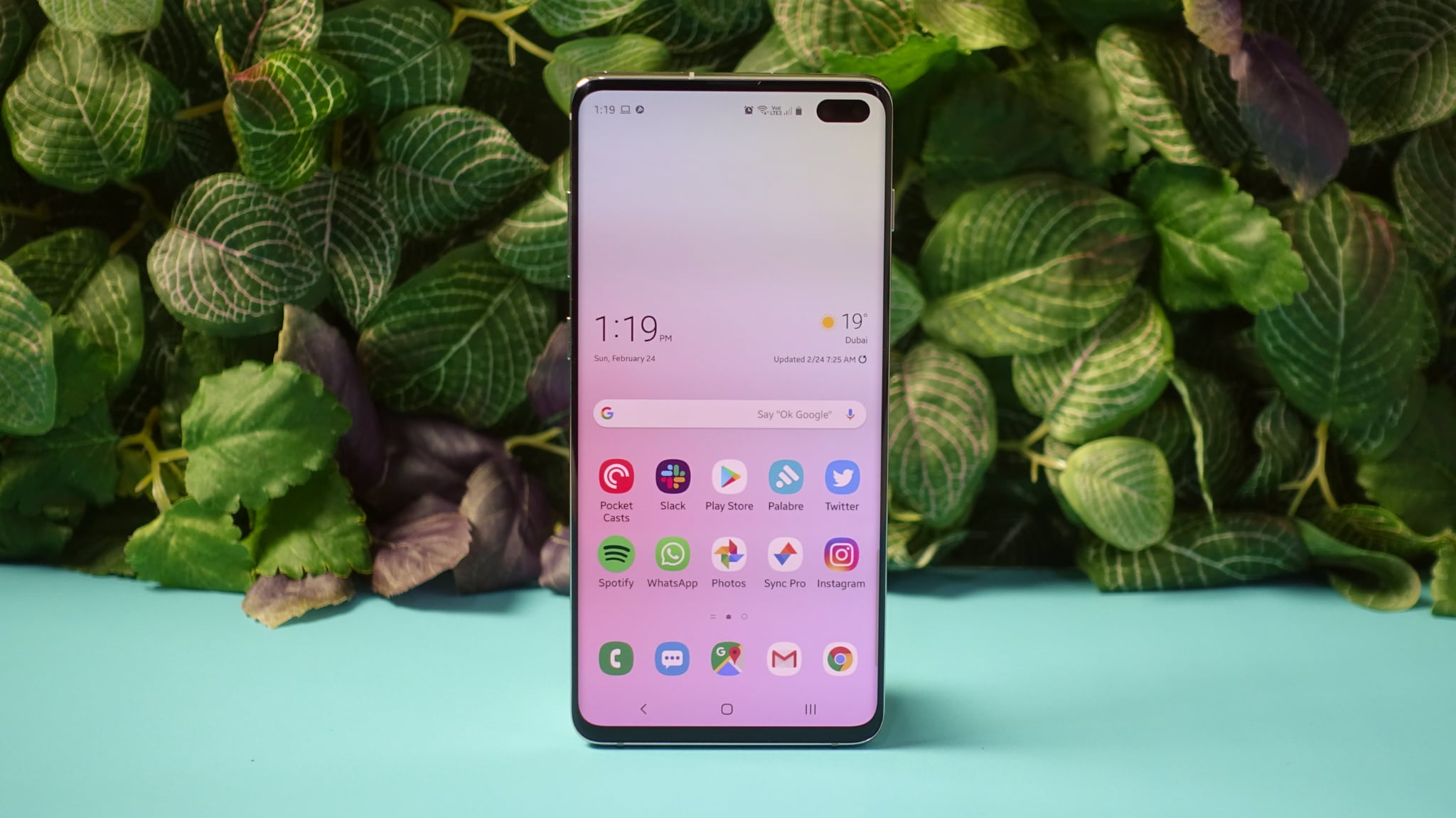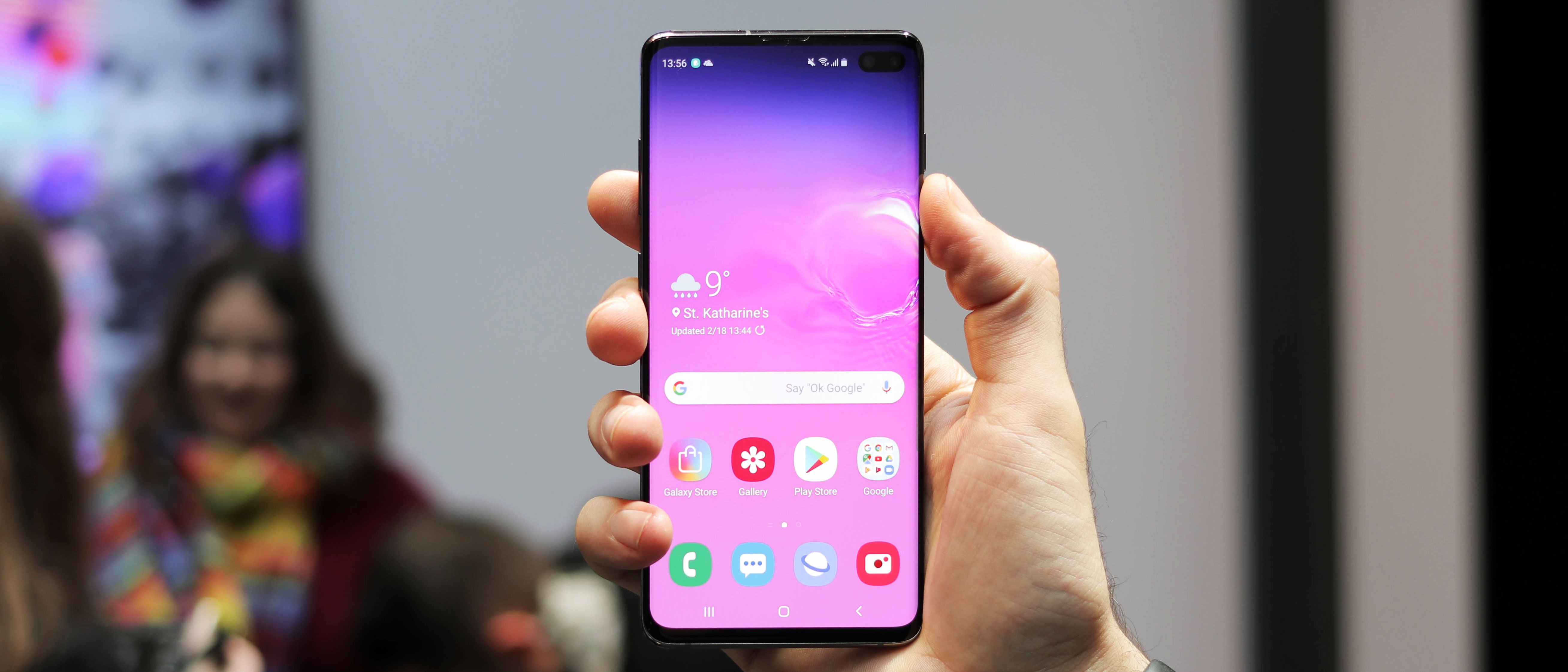Why you can trust TechRadar
Interface and Bixby
The Samsung Galaxy S10 Plus runs the latest version of Google’s mobile operating system, Android 9 Pie, although it’s coated in the South Korean’s firm own interface.
Gone are the days of the overly oppressive TouchWiz UI though; Samsung’s current One UI is more lightweight, although still clearly different from stock Android.

Samsung has also pre-installed three Microsoft apps – Office Mobile, OneDrive and LinkedIn – which can stay hidden away in the app drawer, but which can only be ‘disabled’ and not uninstalled from your device.
Move past the needless additional apps, and the Samsung Galaxy S10 Plus is easy to navigate, with a variety of customization options and additional features accessible via in the settings menu.
Samsung’s always-on display is handy for at-a-glance updates on the time, date and any new notifications you may have, but as mentioned it does drain the battery a little quicker, so you’ll need to keep an eye on that.
The Bixby key on the left of the Samsung Galaxy S10 Plus can be programmed to launch another app, or to run a Bixby ‘quick command’, as well as launching Samsung’s smart assistant.
Bixby Profiles are basically profiles for the phone, so you could set one up for when you get home, get in the car or go to bed, with the ability to toggle settings such as Wi-Fi, Bluetooth, screen brightness and text size, notifications, ringtone volume and auto-playing a playlist.
Press and hold the Bixby key and you’ll be launched straight into Bixby Voice, allowing you to bark commands at the Galaxy S10 Plus in a similar way to how you can with Siri and Google Assistant on other smartphones.
You don’t always need to hold the button to use Bixby Voice though, as setting up voice wake-up allows you to call on the smart assistant at any time – even when the S10 Plus is locked – by simply saying “Hi Bixby”.
Setting up voice wake-up is quick and easy, requiring you to say “Hi Bixby” five times so the S10 Plus can map your voice.
Samsung has improved Bixby too, so you can ask the assistant a wider range of more complex queries, and it can call on other applications to aid with its responses.
The more you use Bixby the smarter and more tailored to your needs it will become, and we’ll continue to experiment with the assistant over the next few months, and update this review with how we’re getting on.
You do have another voice assistant option though, as the S10 Plus also packs Google Assistant. Long-press on the home button and you’ll launch the search giant’s version which, for now, is a more accomplished setup.
Music, movies and gaming
One of the biggest plus (ha ha) points of the Galaxy S10 Plus is its ability to turn its hand to pretty much any task you throw at it, and perform it admirably.
With that in mind, it’s no surprise that this is a smartphone which makes gaming, and music and video consumption, effortless.
The large, QHD+ (if your content hits the resolution, or you’ve manually cranked it up in the settings up from Full HD+) display with HDR10+ means video looks fantastic. Head over to Netflix and the 4K HDR movies are highly detailed, colorful and clear.
The notification bar is automatically blacked out to ‘hide’ the front-facing cameras, ensuring they don’t eat into the content. It does mean video plays off-center, with more padding at the earpiece end, which seems a little odd initially – but you get past it, and the extra space makes for a good thumb rest when you’re holding the handset.
One disadvantage of a curved is that there could be a noticeable blue tint along both curved edge of the screen – we've seen this on the Galaxy S9 as well as the Huawei Mate 20 Pro. It’s more obvious during lighter scenes than darker scenes, and, considering how good the screen on the S10 Plus is otherwise, it’s a bit of a disappointment.
Gaming performance is great on the Galaxy S10 Plus, with high-intensity games running smoothly. Controls are responsive, and there’s no sign of lag.
There’s a novel cooling system in the Galaxy S10 Plus, echoing what we saw in the Note 9. Samsung is touting its vapor chamber cooling as the ideal system for long gaming sessions, and it’s not a perk you’ll get on the S10 or S10e.
We put it to the test with some extended PUBG (PlayerUnknown’s Battleground) gameplay, and while the Galaxy S10 Plus did get warm, it didn’t get uncomfortably hot or appear to slow down due to heat issues – so it appears to work.
The large screen also means controls are better spaced, giving you greater vision of the play area, with less of the action covered by your hands.
There are stereo speakers too, with one on the base of the handset and the other located on the front at the earpiece, delivering audio that isn’t easily muffled by your hands.
The volume on the speakers goes loud enough to fill a room with sound, but it’s not the clearest, and lacks bass.
For a superior audio experience you’re better off using headphones, and the good news here is that the Galaxy S10 Plus comes with a headphone jack, enabling you to plug in a corded set of cans or buds.
There’s also the option to connect wireless headphones, such as the new Samsung Galaxy Buds, which can be wirelessly charged by being placed on the rear of the S10 Plus.
Specs and performance
The Samsung Galaxy S10 Plus is powerful enough to compete with today’s best gaming phones, and that means it has top-of-the-line specs inside. In the Middle East, the phone is equipped with Samsung's top-of-the-line Exynos 9820 chip.

The Exynos 9820 is octa-core and paired with 8GB of RAM (12GB in the Ultimate Performance Edition) to provide plenty of grunt.
We ran Geekbench 4 which scored 10,385- a number that is coming very close to matching the iPhone XS score of 11,481. Outright speed has long been one advantage Apple has held over its chief rival and Android chipset makers are catching up.
Storage on the Samsung Galaxy S10 Plus starts at a healthy 128GB, of which around 110GB is actually available to you out of the box. If that’s not enough space for you there’s a microSD slot which supports cards up to 1TB in size, while the handset also comes in 512GB and 1TB flavors – for an additional cost, of course.
The microSD slot can also be used for a secondary SIM card, provided you get the DUOS version of the phone which is the only official version releasing in the Middle East.
This is the first phone from any manufacturer with next-gen Wi-Fi 6, which allows you to seamlessly transition between Wi-Fi routers and is four times faster than the 802.11ax standard. It should deliver a 20% speed boost compared to the S9, although you’ll need a new router to really get any use out of this feature.

Abbas has been living and breathing tech before phones became smart or clouds started storing data. It all started when he got his very first computer- the Sinclair ZX Spectrum. From computers to mobile phones and watches, Abbas is always interested in tech that is smarter and smaller because he believes that tech shouldn’t be something that gets added to your life- it should be a part of your life.
